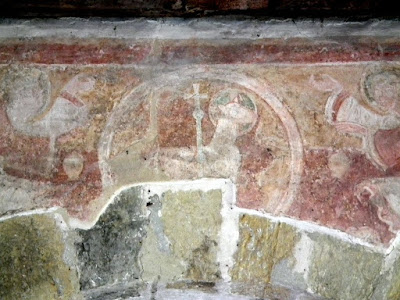 Scenes from the creation of the world to its final end cover almost every inch of the walls, painted by a group of travelling artists who also worked at Clayton, Coombes and Plumpton. It is one of the few places where one can get some feeling for the intensity and drama of churches in medieval times, despite the loss of some sections and the fading of the colours.
Scenes from the creation of the world to its final end cover almost every inch of the walls, painted by a group of travelling artists who also worked at Clayton, Coombes and Plumpton. It is one of the few places where one can get some feeling for the intensity and drama of churches in medieval times, despite the loss of some sections and the fading of the colours.The church itself is a simple two-room building. The only light would have come from the east window and some tiny lancet windows high up. The only alterations since then were some larger windows and, in Victorian times, a north porch and a rather charming little bellcote.
The church was still new when the painters arrived. They plastered the stone walls to create a base which was divided by a grid for the various subjects. Each painter put on a skim coat and worked directly al fresco, onto the wet plaster.
The pigments were simple and local – red and yellow ochre washed from clay, lime white from chalk quarries and carbon black from the soot of oil lamps. The only imported material was the green malachite used in some of the haloes on the east wall of the nave.
The paintings follow a programme, starting with Adam and Eve on the back wall of the chancel. The first parents are shown not simply naked but transparent – their organs are shown as funny sacks and their bones are visible. Eve holds her hand behind her to accept a piece of the forbidden fruit from the serpent, who is winged to indicate his identity as the fallen angel Lucifer. On the other side of the arch, the fallen couple labour away, Eve milking a huge cow and Adam picking fruit in a tree.
The central image of Christ in Majesty on the east wall was destroyed when the window was enlarged but the surrounding figures of seraphim, the twelve apostles and the twenty-four elders of the Apocalypse survive.
The upper images on other walls are filled with pictures of the life of Christ.
The lower images in the nave are devoted to the legend of Dives and Lazarus, including a vigorous depiction of a demon dragging the soul of the rich man to hell, and a famous sequence of the life of St George.
St George had just become wildly popular because of his miraculous appearance to help the Crusaders at the battle of Antioch in 1098, and the church was then dedicated to him. The saint is shown being tortured to death for his faith, and then on horseback with a lance smiting the infidels.
The paintings were whitewashed by the 13th century and discovered in 1866.



